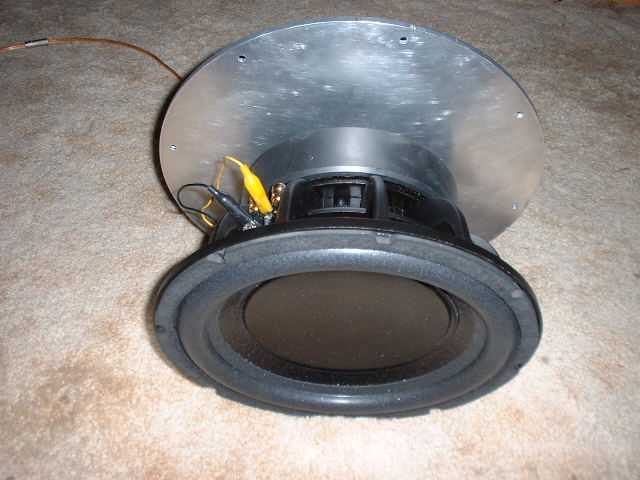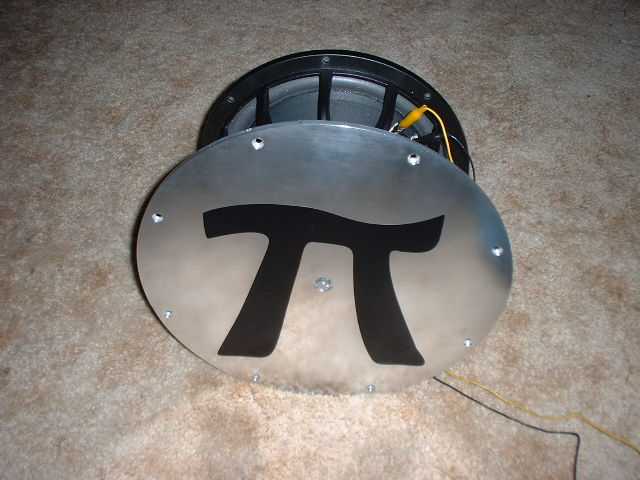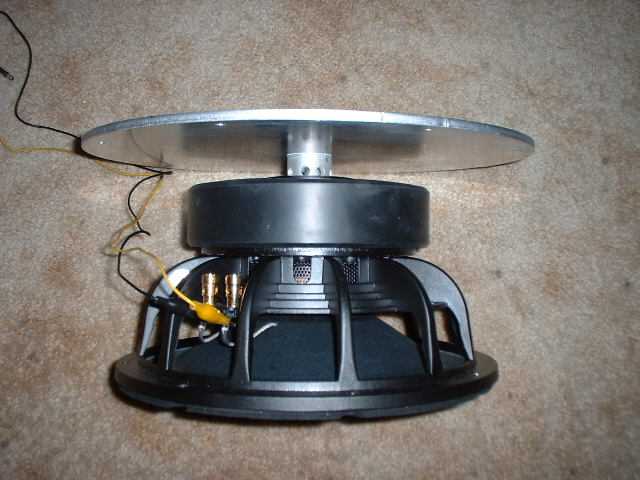

 Woofer and Heat Exchanger Under Test
Woofer and Heat Exchanger Under TestThe last several days, I performed a series of tests to find the limits of the LAB12 with the heat exchanger installed. I intended to push the driver to the point of failure, but after power was well above twice the level that caused it to fail without the heat exchanger, I realized that a destructive test was not really necessary. The LAB12 with a heat exchanger survived 2 hours at 60VRMS, which is approximately 840WRMS. At this point, I decided to end the test.
To tell the truth, I expected a pretty serious power handling improvement, maybe 150% or so. But the measured improvement is at least 225%. At that point I terminated the test, but it could be as much as 250% or 300%.
There is increased output up to about 150%, and above this, at extreme power levels the driver output is compressed but able to dissipate the heat without damage. Thermal failures are made extremely unlikely with the heat exchanger installed because the voice coil enters compression, increases resistance and in a sense, saves itself.
An interesting thing happens above about 600 watts. The test signal I've been using is a 40Hz sine wave, cycled on for 15 seconds and then off for 15 seconds. What happens is that the woofer is very loud initially, when the signal is applied. It stays loud for about 10 seconds, and then begins to trail off, becoming noticeably quieter over the next 5 seconds when the signal shuts off. This doesn't happen below about 500 watts, but starts somewhere above 600 watts. These levels are with the heat exchanger, of course.
The voice coil is obviously becoming very hot, increasing resistance, so power decreases as the driver enters heavy compression. The voice coil radiates heat into the pole piece and the heat exchanger carries it away. After several seconds, enough heat has been carried away that the voice coil is cool enough to lose resistance, and compression goes away. Once the signal has been applied for another ten seconds continuously, it enters compresion again and the process repeats itself.
The heat exchanger provides a significant increase of long-term power capability, and that this improvement translates to increased sound output. It also increases short-term output, because the long-term heat-soaking energy is wicked away by the heat exchanger, allowing the voice coil to remain cool and track transients. It can provide very high output levels for short bursts, under ten seconds or so.
Extended duration high-power signals lasting longer than ten seconds start to cause compression enough to reduce output. But the driver is protected by the heat exchanger, and signals that are in excess of twice the level that would destroy a LAB12 do not harm the driver with the heat exchanger installed. So the advantage of having the heat exchanger is more than providing additional output, it also serves to improve durability. With the heat exchanger installed, the loudspeaker is much more robust, and can handle 800 watts continuously. This helps prevent thermal failures in the field.
Voltage Input Power Level Duration Temp at back of magnet Temp inside at pole piece
============================================================================================
42VRMS 410WRMS 2 hours 108º F 134.2º F
44VRMS 450WRMS 2 hours 110º F 136.5º F
46VRMS 490WRMS 2 hours 113º F 138.7º F
48VRMS 540WRMS 2 hours 116º F 140.5º F
50VRMS 580WRMS 2 hours 118º F 142.6º F
52VRMS 630WRMS 2 hours 120º F 144.7º F
54VRMS 680WRMS 2 hours 122º F 147.2º F
56VRMS 730WRMS 2 hours 123º F 151.7º F
58VRMS 780WRMS 2 hours 125º F 154.6º F
60VRMS 840WRMS 2 hours 127º F 160.1º F
============================================================================================
Compare these values with the driver run without a heat exchanger. With 40VRMS input, it reached 195º F after an hour and a half, and the voice coil had failed. All other conditions were the same.







